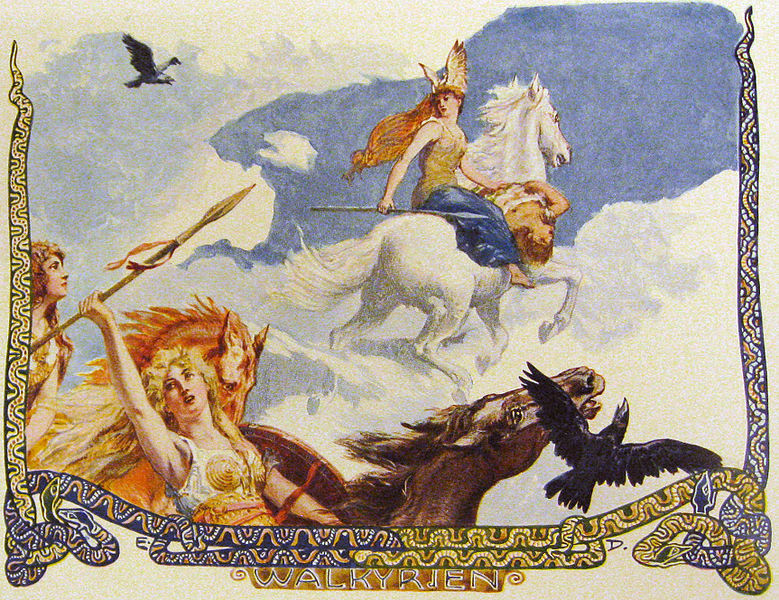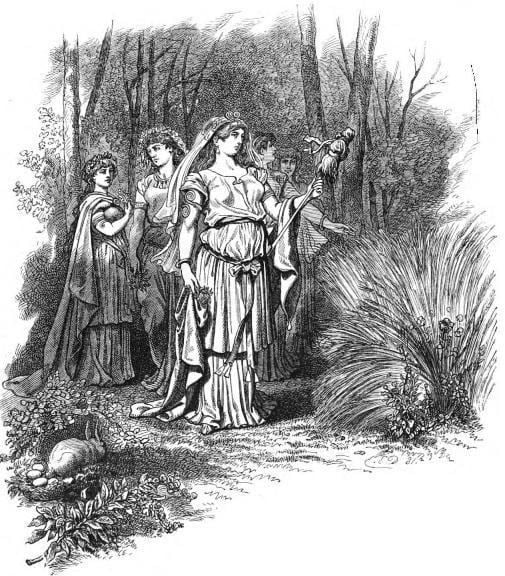
Carl Emil Doepler “Mime”, 1876 Nordic art, Costume design sketch, Germanic tribes
"Forseti Seated in Judgment" by Carl Emil Doepler (1881) Forseti (pronounced "for-SET-ee;" Old Norse Forseti, "Chairman" [1]) is an obscure pre-Christian Norse god. He is mentioned only twice in Old Norse literature. The first mention comes from the 15th stanza of the Grímnismál, one of the poems in the Poetic Edda.

Carl Emil Doepler “Waltraute”, 1876 Character design, Valkyrie costume, Comic artist
Carl Emil Doepler 'The Elder' from Nordisch-Germanische Götter und Helden re-published in 1887 as Unzre Vorzeit by Wilhelm Wagner and Jakob Nover Illustrations varied between the two editions. The following illustrations were published in the first and/or second edition.

Nibelungenhalle — Carl Emil Doepler “Brunnhilde”, “Ortlinde” and... Nordic art, Norse pagan
(Carl Emil Doepler) Mimir's Portrayal in Literature and the Arts. In art, Mimir is most frequently depicted as a head which looms over a well at the foot of Yggdrasil. Odin ensured Mimir's wisdom was never lost, and he protected the decapitated head of the god by embalming it and enchanting it, allowing Mimir to continue to live and speak.

Emil Carl Doepler 'The Elder' Illustrations Illustration, Norse mythology, Norse
When Wagner staged his "Der Ring des Nibelungen" opera cycle in the 1870s, costume designer Carl Emil Doepler created horned helmets for the Viking characters, and an enduring stereotype was born.

Sold Price CARL EMIL DOEPLER II WATERCOLOR August 2, 0121 130 PM CEST
Later on, in the 1870s, costume designer Carl Emil Doepler created horned helmets for the Viking characters of Richard Wagner's "Der Ring des Nibelungen" opera cycle. Alternatively, some experts believe that 19th-century artists could have been inspired by discoveries of ancient horned helmets later determined to predate the Vikings.

Carl Emil Doepler (german, 18241905) by PKFNF Forest landscape, Forest art
Carl Emil Doepler (1824-1905) was a German painter, illustrator and costume designer. [1] He created the costumes for Richard Wagner 's opera Der Ring des Nibelungen at the Bayreuther Festspiele in 1876. [1]

Carl Emil Doepler Fronleichnamsprozession Stock Photo Alamy
Emil Doepler (29 October 1855, in Munich - 21 December 1922, in Berlin) was a German illustrator, graphic artist, and heraldist. He is usually referred to as The Younger, to distinguish him from his father. Life and work He was born to Carl Emil Doepler, an illustrator and designer, who was head of the costume department at the Bayreuth Festival.

Carl Emil Doepler “Rheintochter”, 1876 Opera posters, Creative artists, Artist
To make his characters look especially formidable, costume designer Carl Emil Doepler made sure they were wearing horned helmets. Though the image of Vikings plundering and pillaging while.

Carl Emil Doepler “Helmwige” , 1876 North Mythology, Mythology Art, Greek Mythology, Richard
In 1876, costume designer Carl Emil Doepler sketched out designs for a performance of Richard Wagner's Der Ring des Nibelungen. Doepler gave Vikings' helmets horns and the rest is history. But why? Carl Emil Doepler/Pinterest Carl Emil Doepler gave the Vikings horned helmets, triggering a myth that lasts to this day.

https//flic.kr/p/2iNqKrM doepler, carl emil Courting Couple in a Forest Landscape 1 Carl
The helmet, popularized by Carl Emil Doepler's original Ring Cycle costume designs, was part of a cultural mania, ongoing for a century at least, among Europeans to invent culture through art.

Emil Doepler's Die Götterwelt der Germanen Illustrations
Putting cow-horns on Nordic-looking heads - as Wagner's costume designer, Professor Carl Emil Doepler, did in 1876 for the first Bayreuth production of the full Ring - was not only a departure.

Wagner’s Ring an Epic at The Library & Museum, January 29 April 17, 2016
When Wagner staged his "Der Ring des Nibelungen" opera cycle in the 1870s, costume designer Carl Emil Doepler created horned helmets for the Viking characters, and an enduring stereotype was born.

Carl Emil Doepler 1876 costume designs for the first Ring Cycle Flickr
The Norns and the World-Ash. Image credit: Carl Emil Doepler, Jr. (1905) - Public Domain . According to Prose Edda, the spring is one of the three significant springs at the primary roots of the cosmic tree Yggdrasil. Ancient fairy tales in Norse mythology say that this fantastic sacred ash tree had three roots, which sucked water from three different sources.

Carl Emil Doepler Odin with the wolves Geri and Freki Rob Scholte Museum
Costume designer Carl Emil Doepler, who included horned helmets in his gorgeous costume designs for the 1876 performance of Wagner's classic Norse saga, Der Ring des Nibelungen. The gorgeous.

Carl Emil Doepler (1824 1905)
The image of Vikings with horned helmets first gained popularity in 1876, when costume designer Carl Emil Doepler included them in the costumes for Wagner's opera "Der Ring des Nibelungen." In.

Carl Emil Doepler Alchetron, The Free Social Encyclopedia
Two names worth mentioning here are Michael Echter and Carl Emil Doepler, both German painters working in close contact with Wagner. Michael Echter was commissioned by King Ludwig II to decorate his palace with murals inspired by The Ring, of which the king had grown very fond.